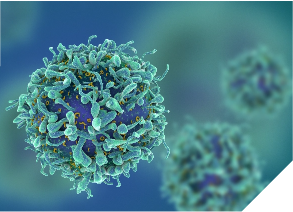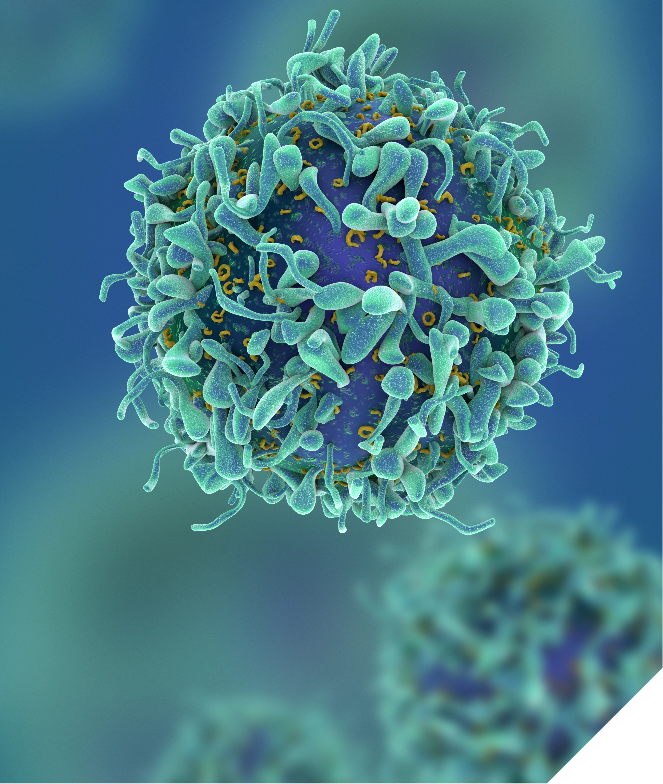Products
Hiltonol® consists of four complexed, high molecular weight polymers in a colloidal suspension. The active pharmaceutical ingredient (API) in Hiltonol® is formed by a synthetic RNA double helix, formed by the polymers poly-inosine (poly-I) and poly-cytidine (poly-C).
Poly-IC imitates a viral genome replication intermediate and activates the immune system via two specific receptors: TLR-3 and MDA5. The principal effect of the binding of poly-IC to TLR-3 and MDA5 is the production of interferon, which stimulates both innate and adaptive immune responses.
The human body possesses high concentrations of the enzyme RNase that cleaves double stranded RNA, a natural protection against viral infections. In order to protect the poly-IC within Hiltonol® against this enzyme, the double helix is complexed with two further polymers, poly-lysine (poly-L) and carboxymethylcellulose (CMC). The complex formed by the four polymers (poly-ICLC) is stable in the human body for a time sufficient to achieve a potent activation of the immune system.
Trials
The capacity of intramuscular Hiltonol® to treat cancer, either alone or in combination with other treatments, has also been amply demonstrated in clinical trials in various indications, including prostate cancer, as well as pediatric and adult brain cancers.
In addition, due to its ability to stimulate potent cellular immune responses, Hiltonol® promises to be a highly effective adjuvant for vaccines against infectious diseases.
Since Hiltonol® functions as a general and powerful immunomodulator, it is proposed that in veterinary area it might be used in all situations where the animal is potentially exposed to disease or suffering immunosuppression.
In addition to intramuscular application, intranasal Hiltonol® has demonstrated the ability in pre-clinical models to protect against a range of respiratory viruses including influenza and Covid-19. In a phase-I trial, intranasal Hiltonol® was found to be safe and immunogenic in healthy volunteers. Intranasal Hiltonol® protects against viral infection for two weeks and could represent a crucial response in public health emergencies caused by respiratory viruses with pandemic potential, independent of the virus and prior to the availability of vaccines.


Orygen collaborates with several groups from Brazilian universities in the development of vaccines against parasitic diseases such as leishmania, malaria and Chagas` Disease. The results of these studies demonstrate the capacity of vaccines containing Hiltonol® to stimulate a robust immune response against these diseases. Thus, inclusion of Hiltonol® may be of great value in the development of therapeutic and prophylactic parasite vaccines.
Related articles
Poly-ICLC, a multi-functional immune modulator for treating cancer
https://pubmed.ncbi.nlm.nih.gov/33011064/
Designing therapeutic cancer vaccines by mimicking viral infections https://pubmed.ncbi.nlm.nih.gov/27052572/
TLR agonists polarize interferon responses in conjunction with dendritic cell vaccination in malignant glioma: a randomized phase II Trial
https://pubmed.ncbi.nlm.nih.gov/38719809/
A combinatory vaccine with IMA950 plus varlilumab promotes effector memory T-cell differentiation in the peripheral blood of patients with low-grade gliomas
https://pubmed.ncbi.nlm.nih.gov/37758193/
Randomized trial of neoadjuvant vaccination with tumor-cell lysate induces T cell response in low-grade gliomas
https://pubmed.ncbi.nlm.nih.gov/34882581/
Double-Stranded RNA Immunomodulators in Prostate Cancer https://pubmed.ncbi.nlm.nih.gov/33446322/
Promotion of neutralizing antibody-independent immunity to wild-type and SARS-CoV-2 variants of concern using an RBD-Nucleocapsid fusion protein
https://pubmed.ncbi.nlm.nih.gov/35977933/
Non-clinical toxicity and immunogenicity evaluation of a Plasmodium vivax malaria vaccine using Poly-ICLC (Hiltonol®) as adjuvant
https://pubmed.ncbi.nlm.nih.gov/38448321/
ASP-2/Trans-sialidase chimeric protein induces robust protective immunity in experimental models of Chagas’ disease
https://pubmed.ncbi.nlm.nih.gov/37258518/
Pipeline
Latin America
Hiltonol® as a standalone medication
• Veterinary immunomodulator
• Treatment of veterinary malignant solid tumors
Related article
Intratumoral (Poly-ICLC) Therapy for Dogs with Advanced Cancers: First Report on Clinical Effectiveness, Quality of Life, and Adverse Events
• Treatment of canine leishmaniosis
• Prophylactic intranasal agent for viral respiratory human diseases, in partnership with Oncovir
Vaccines incorporating Hiltonol®, under development in Brazil
• Covid-19, Ricardo Gazzinelli, UFMG
Related article
Promotion of neutralizing antibody-independent immunity to wild-type and SARS-CoV-2 variants of concern using an RBD-Nucleocapsid fusion protein
• Leishmania (therapeutic vaccine), Ana Paula Fernandes, UFMG
• Chagas disease (therapeutic vaccine), Ricardo Gazzinelli, UFMG
Related article
ASP-2/Trans-sialidase chimeric protein induces robust protective immunity in experimental models of Chagas disease
• Covid-19, Leda Castilho, UFRJ
• Zika, Leda Castilho, UFRJ
• Covid-19 (intranasal), Jorge Kalil, InCor (HC FMUSP)
• Malária (Plasmodium vivax), Irene Soares, USP
Related article
Non-clinical toxicity and immunogenicity evaluation of a Plasmodium vivax malaria vaccine using Poly-ICLC (Hiltonol®) as adjuvant
• Other applications being developed by Oncovir and their partners outside Latin America
